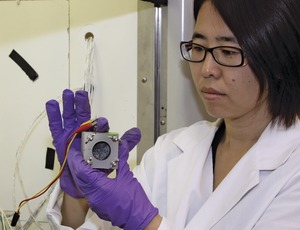
Researchers at Oregon State University have successfully lab-tested a new microbial fuel cell that can produce 10 to 50 times more electricity, per water volume, than other approaches.
Microbial fuel cells (MFCs) are kind of like battery units in which bacteria consume organic matter in wastewater. Researchers use the energy from the consumption to produce electricity and clean the wastewater. The process uses biological catabolism, or fermentation, to oxidize a substrate and produce energy, says Hong Liu, associate professor of biological and ecological engineering at Oregon State University, Corvallis.
Liu says the greatest challenge of MFC technology for practical applications is the amount of power they generate. "That has been the focus of our research in the past two to three years," she says. Power density in MFCs is affected by what is used in the process, including the bacterial culture, the size of the electrode, the substrates and oxidants as well as the kind of reactor, which carries out the process of cleaning and producing electricity.
Liu's team reduced the anode-cathode spacing and the use of evolved microbes and new separator materials. The new separator materials between the anode and cathode side of the microbial cell is an important advance for energy gain, she says.
"It's an oxygen-tolerant bio film that reduces the internal resistance of the system,"she says. It allows the device to produce more than two kilowatts of power per cubic meter of liquid reactor volume, according to lab tests using a reactor the size of a book.
"It's a nice accomplishment. They've been able to get more power per area of electrode than anybody else," says Bruce Logan, a Penn State professor of environmental engineering who has been working with MFCs for years. But he points out that, in the lab, synthetic wastewater is used. "The electrode spacing is very close, and the reactor volume is very small. It may be difficult to use with real wastewater."
If it scales successfully, the new MFC has the capacity to change wastewater facilities from energy drains into energy producers, Liu says. "Wastewater treatment plants nationwide account for 3% of our total energy usage," she adds. To do their next pilot study, Liu and her team are looking for a small-scale, decentralized wastewater treatment facility.
If Liu's MFC technology is successful, wastewater treatment facilities could make enough electricity to power operations and feed excess power to the grid.
"If we get the funding, we can scale up the system in six months to a year," she says. "Maybe 10 years from now, we can change how wastewater is treated around the world."


Post a comment to this article
Report Abusive Comment